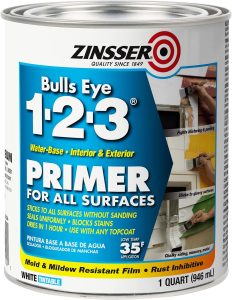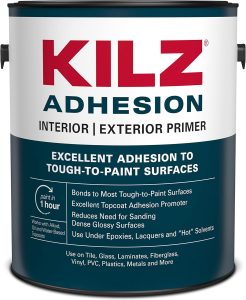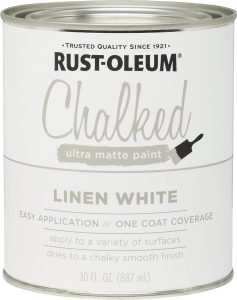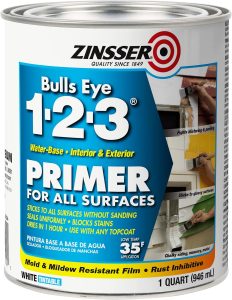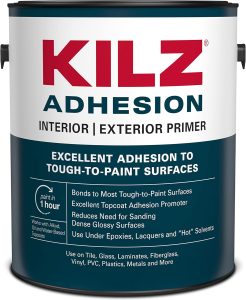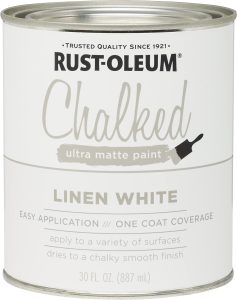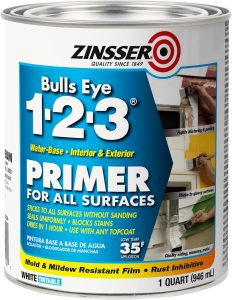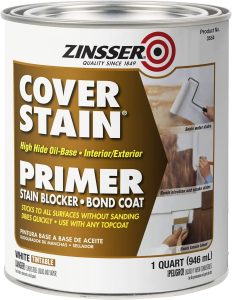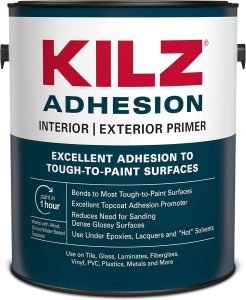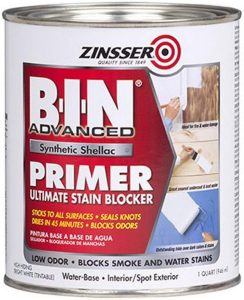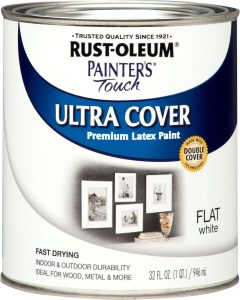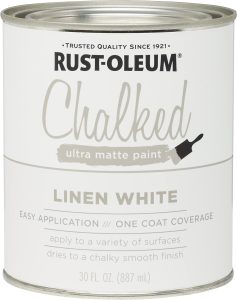Priming the surface before painting the living room or a patio table may increase adhesion, prevent peeling, and minimize the number of coats required to complete the project.
You’re in the right place if you search for the best white primer paint for wood! This guide includes amazing information about white primers paint for wood.
So, read on and learn about the best white primers you can find on the market.
What you will know about white wood paint primers:
My Top Picks For White Wood Primer
- Compatible with both interior and outdoor surfaces
- Adheres to all surfaces without the need for sanding.
- Seals leak stains, graffiti, and tannin.
- Mold and mildew resistant barrier
- Rust inhibitor – ideal for new metals
- A strong bonding primer is required to guarantee that topcoats stick to areas that are difficult to paint.
- A primer with high adhesion expands painting options by adhering to various surfaces.
- Use on surfaces that have been adequately prepared and are free of dust, grease, chalk, corrosion, and flaking paint.
- One coat coverage for a variety of surfaces
- Simple application
- only for use inside
- Completely dries to a silky smooth finish
- Easily damaged to provide a vintage appearance.
Comparison Of The Best White Primers Paint For Wood
1. Best Water-Based Primer Model- Zinsser 02004 Bulls Eye 1-2-3 All Surface Primer
- Unit/Quantity– 32 Fl Oz
- Product Weight– 2.15 pounds
- Style– Water-based primer
- Finish– Matte
- Latest Price – Amazon
2. Best White Primer Paint For Exterior- KILZ L211101 Adhesion High-Bonding Interior Latex Primer
- Unit/ Quantity– 1 Gallon
- Product Weight– 12.21 pounds
- Style– Latex primer
- Finish– Glossy
- Latest Price – Amazon
3. Best White Chalked Primer Paint For Wood- Rust-Oleum Brands 285140
- Unit/Quantity-1 Quart
- Product Weight– 2.5 pounds
- Style– Water-based Primer
- Finish– Matte
- Latest Price – Amazon
What Are Paint Primers?
Primers are undercoats used to prepare surfaces for painting. Primers ensure that the paint adheres effectively to the surface by enhancing its adhesive properties.
In addition to improving the endurance of paint, primers are valued for their protective properties. Primers are designed to improve adhesion to working surfaces and serve as a binding layer.
Primers are used on a variety of surfaces. They are favored with porous surfaces such as concrete and wood.
Do I Always Need To Prime Before Painting?
Before beginning a painting job, a typical question is whether priming a wall is required. The straightforward response is that primer is not always required; thus, it is feasible to save money by skipping it.
In many instances, however, priming will save you money since it minimizes the amount of more costly topcoats required to get attractive, long-lasting effects.
Is There a Difference Between Water-based And White Oil-based Primers?
Walls and ceilings that need new work and preparation are often primed with a water-based primer, whereas oil-based primer is typically used for doors, windows, metal, and woodwork. Enamel is more durable; thus, surfaces subject to high traffic or the weather are often painted with enamel.
Typically, oil-based primer is utilized for tasks requiring a tight seal. Primers based on water are suitable for indoor locations that are unlikely to come into touch with water. Oil-based paint emits more volatile organic compounds than water-based paint, making it less ideal for interior usage.
In the past, water-based primers were believed to be less durable than oil-based primers. Nevertheless, water-based primers have evolved throughout time.
Let’s jump in.
Differences Between Oil And Water-based Primer
We begin with a comparison of oil-based and water-based paint.
Here are a few distinctions:
- Primers based on water are easy to clean up. A primer with a water base may be cleaned with water. This reduces the requirement for specialized solutions.
- Oil-based primer often dries more slowly than water-based primer. However, this might vary by brand and variety.
- Priming wood with an oil-based primer is optimal. The oil seals the wood’s grains and prevents the paint from bubbling due to water damage.
- Oil-based paint emits more volatile organic chemicals (VOCs). As a result, oil-based primer is not recommended for indoor usage, as the VOCs might be dangerous if inhaled.
Does Priming With Any Kind Of Paint Protect Against Future Damage From Nail Holes, Dents, Etc.?
Primers are an excellent method to safeguard your walls from stains and other harm. Additionally, they may assist your paint adhering to the wall, making it simpler to paint the wall evenly and swiftly. When imperfections are evident through lighter color tones, it is beneficial to use a primer. This will assist the fresh paint in covering these flaws more successfully.
What Is The Best White Primer Paint For Wood?
1. Zinsser 02004 Bulls Eye 1-2-3 All Surface Primer
The Zinsser white primer best water-based white primer paint for wood, is first on this list. The name derives from the product’s simplicity since nothing is complicated. It works on almost any surface, its brilliant color pulls out the paint beautifully, and it conceals stains like a pro.
Special Features:
- This one adheres well to most surfaces without sanding.
- This saves both time and money on sandpaper.
- Its consistency is neither too thick nor too thin, making it simple to apply without leaving markings and allowing for speedy application.
- Also, there is no need to worry about the top coat since this primer is compatible with almost every finish.
What We Liked In This White Wood Primer
- Excellent stain repellent and color enhancer
- Excellent for high pH surfaces
- Compatible with all paints and most surfaces
- No sanding is required for adherence
- Typically flows quickly and smoothly
What We Didn’t Like In This White Wood Primer:
- Most pricey on our list
- Unsuitable for particle board
2. Rust-Oleum 3554 Zinsser High Hide Cover Stain Primer And Sealer
The Rust-Oleum best oil-based white primer paint for wood, is an excellent starting point. As you may have guessed from the header, this item is the most reflective on my list. Oil-based primers are already glossy. Therefore, the addition of a polyurethane sealer will simply enhance this characteristic.
Even if you intend to paint over this material, the additional shine will impact the appearance of the paint. Obtain this product if you want your hardwood surfaces to gleam in the sunlight.
Special Features:
- Due to the oil and poly, the finish is highly durable and should last very long.
- Flexibility is essential for a wood primer since wooden things constantly expand and contract over time.
- The best topcoat to eliminate flaking.
What We Liked In This White Wood Primer:
- Delivers extensive protection against dampness
- Produces a very durable and glossy finish
- No sanding is required for adherence
- Dries relatively fast
- Offers a flexible coating
What We Didn’t Like In This White Wood Primer:
- Somewhat poisonous and flammable
- Only available in quarts
3. KILZ L211101 Adhesion High-Bonding Interior Latex Primer
Use Kilz adhesion best high bonding primer paint for wood, if you are concerned that your new paint will not adhere properly. This is particularly helpful if you want to paint over a glossy or semi-gloss finish.
Special Features:
- In some aspects, this water-based solution behaves more like an oil-based product.
- This provides some benefits from both products.
- It has the durability of an oil finish but the simple maintenance of a water finish.
- Obviously, this material will not be as hard as a proper oil-based primer, but it is more durable.
What We Liked In This White Wood Primer:
- Superior at concealing stains and prior finishes.
- Adheres firmly to even slippery surfaces.
- Rapid drying time
What We Didn’t Like In This White Wood Primer:
- Dense formula.
4. B-I-N Advanced Synthetic Shellac Zinsser 271009 Primer
Zinsser is the best-advanced shellac white primer paint for wood belonging to the Rust-Oleum family. This product is among the oldest and most reliable shellac-based primers and sealers available on the market. Primers composed of shellac are regarded as heavy-duty materials. Shellac is the best option for concealing stains and smells on freshly painted or unfinished wood surfaces.
Remember that shellac-based primers contain the most volatile chemical components and a strong odor (VOCs). If you are enclosed, your room must have enough ventilation.
Special Features:
- Compared to other shellac choices, it dries quickly.
- Shellac primers typically dry quicker than oil-based primers but not faster than water-based primers; nonetheless, this primer is unique.
- It dries quicker than water-based alternatives.
- You can apply a second or final coat in 20 minutes.
What We Liked In This White Wood Primer:
- Excellent for odor control
- It may be written on with dry-erase markers.
- Superior to other choices in terms of performance.
- Interior and exterior spot
What We Didn’t Like In This White Wood Primer:
- Contains many VOCs
5. Rust-Oleum 1990502 Painter’s Touch
The Rust-Oleum best latex-based white primer paint for wood is available in two color options: white and gray. This product’s consistency and quality are such that you might use it as a solo color for your woodwork creations. It is also excellent for use on trim and furniture because of its deep color and short drying time. You may need to apply an extra layer for the decoration.
Special Features:
- As is typical of latex paint, it has a very low odor, so you will not be exposed to dangerous fumes.
- It is relatively thick, so one application is plenty for covering. This implies that you may complete your job quicker and with less effort.
- If you are short on time and need a quick-drying alternative, this is an attractive choice.
What We Liked In This White Wood Primer:
- Provides good coverage
- Outstanding for permeable surfaces
- Fast-drying
- Indoor/outdoor
What We Didn’t Like In This White Wood Primer:
- Excessive brushing might result in stains
- Not effective with shiny surfaces
6. Rust-Oleum Chalked Linen White Primer
If you want to try your hand at a DIY project but don’t have much time, this Rust-Oleum best Chalky Finish Furniture white primer Paint for wood is an excellent option for simple furniture painting. It does not need sanding or priming before application, and it is a water-based color with a slight odor so that it may be applied inside with only a few sheets of newspaper for protection. However, this means that it can only be used on inside furniture since the paint would not withstand the weather effectively.
Special Features:
- With over 30 color options, including the traditional Antique White, Mustard, Pumpkin, and Winter Gray.
- There are various options for changing your old furniture into one-of-a-kind pieces.
- This is the most effective furniture paint for achieving a shabby chic appearance.
- Water-Based primer with no odor.
What We Liked In This White Wood Primer:
- It takes little prep
- It is simple to apply and immediately dries.
- The most effective varnish for wooden shelves
- It turns fresh furniture into something enchanted.
What We Didn’t Like In This White Wood Primer:
- If the paint is not well-blended, it might come out in chunks.
- It might be costly if you need to cover a vast region.
Related Content: Best Spray Primers For Wood
Choosing A White Primer – What Else Should You Think?
Several factors should be considered while selecting a primer for your project. The best paint primers cover various surfaces swiftly, prevent stains, and produce a uniform, smooth topcoat. Here are further insights into crucial characteristics when selecting a paint primer.
Project Environment
Primers for paint are available in three varieties: interior/exterior, exterior, and interior.
Interior/exterior primers are suitable for use both inside and outdoors, while exterior primers are intended for use just outside.
Both include chemicals that prevent UV-related fading and moisture-related mold growth; they also allow the paint to tolerate frequent outdoor temperature fluctuations, reducing peeling and cracking.
Without external additives, interior primers are only acceptable for indoor usage. Interior/exterior primer is ideal for various interior and outdoor painting projects.
Additionally, selecting a primer that can be used both inside and outside reduces the expense of purchasing separate interior and exterior supplies.
Surface
Each kind of primer may cling to various surfaces more effectively. The following describes the optimal primer for typical domestic surfaces:
Wood that has never been stained or painted should be primed using an oil-based or latex primer to help seal the porous surface. Remember that oil-based primers produce more volatile organic compounds (odorous pollutants) than latex primers.
On drywall, use a latex primer since an oil-based primer might elevate the grain and create an uneven surface.
Use a stain-blocking primer on stained wood, raw wood with a high tannin content that may bleed out (such as cedar or redwood), interior walls with water or smoke stains, and cabinets/trim with grease stains. It will prevent stains from leaking into topcoats and discoloring them.
Select a latex stain-blocking primer for solvent-based stains (e.g., crayons or grease).
Choose an oil-based stain-blocking primer for water-based stains (e.g., water-based wood stain, smoke, or tannin).
It will dry into a denser, smoother base to reduce these flaws.
Glossy surfaces: A bonding primer designed to adhere to glossy surfaces is required for smooth surfaces such as glass, plastic, and glazed tile.
Dedicated Primer vs Paint-and-Primer in One
Self-priming paints, often known as paint-and-primer combination solutions, enable users to prime and paint a surface simultaneously. However, these two-in-one items are only advised if the following conditions are met:
- You are not painting unstained or bare wood.
- Your painting’s surface is free of stains and peeling.
- You are repainting a previously painted surface with the same or deeper color.
Choose different paint and primer in the following instances to optimize paint adhesion:
- You are painting unstained or unfinished wood.
- You are painting over a stained and flaking surface.
- You are moving from darker paint color to a lighter one.
- You should use a paint having a distinct base than the primer. For instance, use an oil-based primer with latex paint to take advantage of the oil primer’s rot resistance and the latex paint’s reduced VOC content and shorter drying time.
- You want to paint over the existing oil-based paint with latex paint. An intermediate coat of specialized primer is required for adequate adherence to the latex paint.
Primers are often white or gray. Use either color without tinting it, or tint the primer to a slightly lighter shade than the topcoat. Tinting primer, which necessitates the purchase of a “tintable” primer, provides a deeper, richer, and more uniform final color but is suggested in the following circumstances:
- You are altering the color to become lighter. The tinted primer minimizes the paint required to conceal the darker base coat.
- For tenacious stains, such as water or mildew, a tinted primer is required to prevent the stain from leaking through, particularly when the topcoat is of a light hue.
- You are transitioning from a lighter to a much darker hue, such as light blue to black. The tinted primer guarantees that no white or gray priming patches will be visible even if the topcoat is uneven.
Dry Period
Pay attention to the “dry-to-recoat” period given on the primer package, which indicates when the primer is sufficiently dry to be reapplied with another coat of primer or paint.
Latex primers offer a quicker dry-to-recoat time of no more than one hour, but oil-based primers need between one and three hours to be reapplied.
Related Content: Best Sandable Primer For Wood
How To Prime Perfectly Every Time – Quick Steps For Best Results
Priming a wall before painting will improve the topcoat’s quality and prolong the paint job’s life. The primer enables the real color of the topcoat paint to show through.
Many people believe applying a paint primer is time-consuming or unnecessary, but if you want the greatest possible appearance, you must use one. Priming paint is not difficult to apply. To get the desired outcomes, good technique is essential.
Step 1 Prepare The Location
The surrounding environment must be protected with any painting process. Move furniture out of the room, arrange it away from the walls, and drape a drop cloth or tarp over it. Also, safeguard your flooring. Before applying paint primer on the wall, it must be well cleaned. Any residue on the wall might prevent the paint primer from adhering correctly.
Scrutinize the wall and, using the hammer, drive protruding nails slightly below the wall’s surface or remove them entirely. Use a screwdriver to push screws further into the wall or remove them from the surface.
Use putty to fill any holes in the wall. Allow it to dry thoroughly, then gently sand it. Wipe the walls with soapy water, and then use a moist, lint-free cloth to remove any residue. Apply painter’s tape around the wall where paint priming is not desired.
Step 2 – Select the Priming Paint
Choosing a paint primer is crucial for defining the appearance of the final paint job. You must select between oil and latex primers for painting. A primer with a latex base is more flexible and simpler to apply. Also resistant to peeling and breaking, latex paint primer is easily cleaned with soap and water.
Oil-based primer paint penetrates the wood more profoundly and prevents the tannin in the wood from reaching the surface. This primer is suitable for use on milled timber.
Step 3 – Paint Primer Application
When you get the primer from the retailer, request to shake it properly. Before beginning your job, swirl the paint primer from the bottom of the can to recombine any chemical separation that may have occurred. Place a portion of the primer in a paint tray. Use a paintbrush to apply priming around the wall’s perimeter before painting. To prevent the primer from going behind the masking tape, brush away from it.
Cover the whole surface with the primer without creating excessively thick layers. Also, allow sufficient time to dry before painting over it so that it has time to adhere to the wall properly and is prepared to receive the paint coat—advice on what primer and paint to use on the base and drawer.
Before selecting paint for a piece of furniture, it is essential to evaluate its intended usage since various paints provide varying degrees of durability.
Chalk paint is fast and simple to apply since it often requires little preparation. As it is more prone to chipping and smudging, it is usually reserved for ornamental elements like picture or mirror frames, particularly on high-traffic surfaces such as the top of a coffee table or a cabinet door.
If you enjoy the aesthetic of chalk paint but need a more lasting solution, you may either seal the paint with wax or polyurethane or use a matte-finish, more durable paint.
Typically, acrylic paints are more durable than chalk paints. They may be cleaned, scraped, and hardened into a more scratch-resistant finish.
Frequently Asked Questions:
Can A Wood White Primer Be Tinted?
While a paint company will color the primer for you, you can also tint it by mixing in part of the colored paint. Ensure that the primer and paint are compatible before combining them.
Will Your Wood Grain Telegraph Stain, Grain, And Knots?
The grain is the distinguishing characteristic of each species of wood. This grain will “telegraph” through the stain or be visible.
Should You Prime Bare Wood Before Painting?
Before painting, unfinished or naked wood surfaces must always be primed. This applies to both interior and outdoor painting work. Because wood is porous and has a grainy texture, it cannot be painted without priming. Due to the primer’s high solids content, it helps fill the wood’s grain.
What Primer Should I Use For White Paint?
If you want to avoid applying five or six coats of paint, you should prime over the fire engine red before applying the picture-perfect white. Gray is often the preferred primer hue for covering or preparing walls for solid colors.
Best Primer For New Exterior Wood Door?
KILZ 2 All-Purpose Primer is another product designed for interior and outdoor use. This sealant and stain blocker based on water would be a perfect option for painting your front door or garden fence.
Related Content: Best Clear Primers For Wood
Conclusion
Many individuals may consider primers a small affair, but those who care about saving money and boosting the paint’s longevity should consider primers seriously.
This paint layer will guarantee that your home inside is pleasing to the visitors’ eyes. Therefore, it must turn out well.
This information will help you pick the best wood primers for your next painting project. So prepare your paint brushes, wood priming, and paint!


